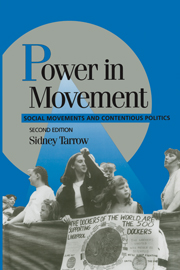Book contents
- Frontmatter
- Contents
- List of Figures
- Preface
- Acknowledgments
- Introduction
- 1 Contentious Politics and Social Movements
- PART 1 THE BIRTH OF THE MODERN SOCIAL MOVEMENT
- PART II FROM CONTENTION TO SOCIAL MOVEMENTS
- 5 Political Opportunities and Constraints
- 6 Acting Contentiously
- 7 Framing Contention
- 8 Mobilizing Structures and Contentious Politics
- PART III THE DYNAMICS OF MOVEMENT
- Conclusion: The Future of Social Movements
- Notes
- Sources
- Index
- CAMBRIDGE STUDIES IN COMPARATIVE POLITICS
8 - Mobilizing Structures and Contentious Politics
Published online by Cambridge University Press: 05 June 2012
- Frontmatter
- Contents
- List of Figures
- Preface
- Acknowledgments
- Introduction
- 1 Contentious Politics and Social Movements
- PART 1 THE BIRTH OF THE MODERN SOCIAL MOVEMENT
- PART II FROM CONTENTION TO SOCIAL MOVEMENTS
- 5 Political Opportunities and Constraints
- 6 Acting Contentiously
- 7 Framing Contention
- 8 Mobilizing Structures and Contentious Politics
- PART III THE DYNAMICS OF MOVEMENT
- Conclusion: The Future of Social Movements
- Notes
- Sources
- Index
- CAMBRIDGE STUDIES IN COMPARATIVE POLITICS
Summary
Social movements do not depend on framing alone; they must bring people together in the field, shape coalitions, confront opponents, and assure their own future after the exhilaration of the peak of mobilization has passed. This takes us to the third type of resource that movements muster: mobilizing structures. Ever since social movements became a force for change in the modern world, observers and activists have puzzled over the effects of organization on their capacity for contention. Some theorists have argued that without leadership exercised through organizations, rebellion remains “primitive” and soon disintegrates (Hobsbawm 1959). Others are persuaded that, far from inspiring people to action, organizational leaders can deprive them of their major power – the power to disrupt (Piven and Cloward 1977). The theoretical support for this position comes from Robert Michels's “Iron Law of Oligarchy,” which holds that, over time, organizations displace their original goals, become wedded to routine, and ultimately accept the rules of the game of the existing system (Michels 1962).
Bur as must be obvious, some leaders, working through certain kinds of organizations in particular situations, do transform contention into movements and sustain conflict with opponents, while others do not. Equally obvious, some movements emerge without formal leadership, often producing leaders out of the experience of struggle – or from cognate groups from which they borrow resources. How are we to explain this diversity of organizational roles?
- Type
- Chapter
- Information
- Power in MovementSocial Movements and Contentious Politics, pp. 123 - 138Publisher: Cambridge University PressPrint publication year: 1998

